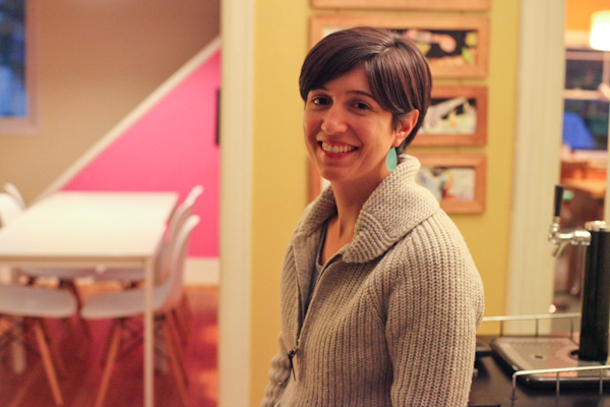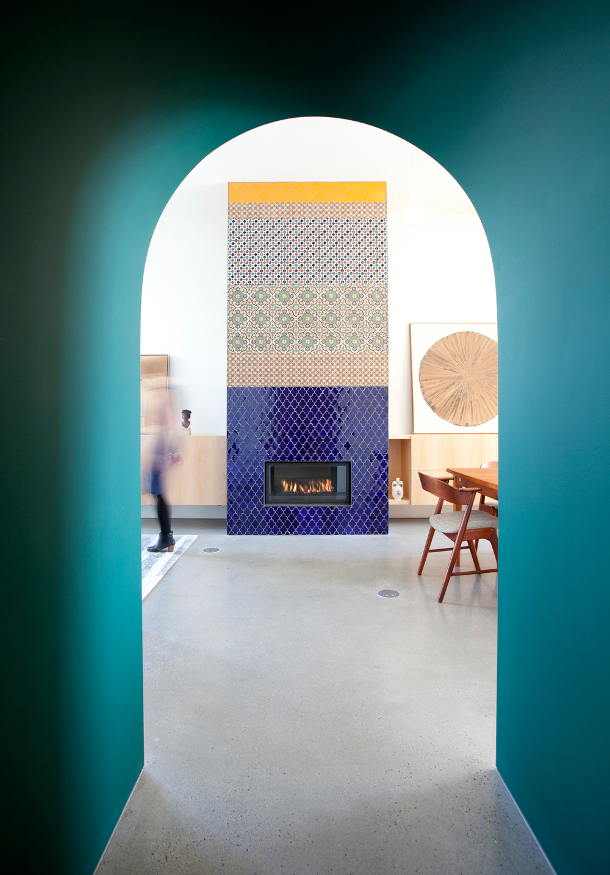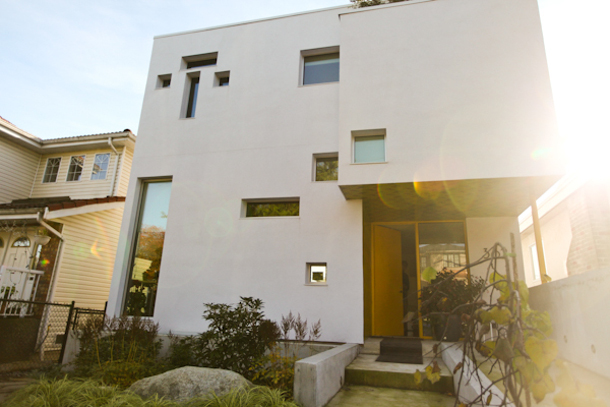"This is what I'm talking about," says Raymond (who for privacy reasons asked that The Tyee not use his surname) as we step onto a tiny balcony overlooking his backyard in the South Main area. No larger than two people, the balcony is a perfect retreat from other members of the four couples who moved into what he calls a "MAD House," short for multi-adult dwelling.
"Sometimes you just want to be alone -- there are places here you can get away, where you can just be alone and not feel grumpy about it," he explains. It's one of three such balconies, interior nooks and other features that help the 2,880-square-foot, three-storey home allow everyone to share both space and privacy.
While some realtors may insist that Vancouver still offers affordable homes if people will simply adapt their expectations, many residents would disagree. And some aren't waiting for a new mayor or the province to change things.
Raymond's MAD house is one example of the many freethinking new ideas being considered, tried and tested in the Vancouver region, as people seek different financial and physical blueprints for what they want in a stable, secure home.
Over the next few weeks, I'll be exploring this optimistic new wave of answers to one of the city's most deadlocked social crises in a series of reports.
Raymond built the dwelling on a small property he's long owned with his wife, but when it was completed, six other adults moved in: his three children and their partners. But the space could as easily be shared by a group of friends, he says. Building a new house on the lot cost him roughly $1 million. But Raymond believes it could be done for less, with the costs split among the residents.
Raymond is typical of a growing movement in Vancouver that's seeking, inventing or adapting housing solutions that others might consider, well, a little mad: buying and living communally; smaller private units with more shared amenities; flexible suite layouts that can enlarge or contract as residents need more or less space through life; or small bands of young creatives pooling savings to move into a shared mansion (stay tuned for that story later in this series).
Marianne Amodio became an early MAD house advisor and ally. An architect who's worked on conventional large condominium projects, Amodio's happier these days to work with individuals like Raymond who want to think outside the box on home ownership.
"A lot of people have been priced out of the market; that's a negative and difficult thing, right?" Amodio agrees. But, she says, there's a "silver lining" emerging. "People are getting creative. They're looking for creative ways to achieve homeownership, which they just can't achieve in the traditional manner."
The trend has already taken root in other major cities. In many cases that means re-thinking the idea of one nuclear family per home, one home per lot, and a single-family mortgage.
One example is Options for Homes, a non-profit with a 20-year history of offering second mortgages to 5,000 families in Montreal, Toronto and other cities. The ensuing returns have built up a $200-million fund that now finances the construction of hundreds of new housing units every year.
The success story arose from bad news. "The government cut off funding for subsidized rental housing in 1992," says Options for Homes CEO, Michel Labbé. Too many people, he says, are still "hoping upper levels of government will start to provide subsidies again. It's been 20 years. Waiting your entire career, in my opinion, isn't very fun."
Most families, Labbé argues, would prefer ownership. "They want a home." And even with Vancouver's sky-high real estate, he insists that the cost of building condominiums under his model is lower than building rental units. "So if it's less expensive to build and operate ownership, why are we so focused on rental? We could put support into ownership and start to build up capital."
Calgary, meanwhile, has seen its City Hall-founded but independently run Attainable Homes put hundreds of former renters into their own units for the first time. And here in Vancouver, the Catalyst Community Development Society is helping B.C. religious communities and nonprofits that already own property become their own developers. In the process, many have learned surprising lessons about faith, gifts and community.
Necessity drives invention
"There's a common recognition that we're at this crisis point in our city," explained Heather Tremain, an architect and founder of Urban Fabric, a consultancy that focuses on social, environmental and economic sustainability at the neighbourhood and city level. "It is really a crisis of providing ownership opportunities to the middle class.
"A lot are young professionals... it's almost a generational issue. This is a group of people who, through no fault of their own except being born at the wrong time, are being squeezed out of the market."
Polls support that reading. As municipal elections approach on Nov. 15, an online survey of 2,138 residents of the Metro Vancouver Regional District, using data up to Oct. 5, found that housing led respondents' choice as the region's most important issue (22 per cent of respondents, followed by transportation at 19 per cent).
Concern was highest in the City of Vancouver (46 per cent of respondents called housing the most important issue), but significant too in Burnaby (21 per cent), Richmond (28 per cent), and Abbotsford (21 per cent). Even on the North Shore, housing came in a close second to transportation with 29 per cent of respondents.
Among Canadians, Vancouverites spend the largest chunk of earnings on their housing: 33.5 per cent of us pay more than what's considered an affordable amount, according to the 2011 National Household Survey.
Tremain believes that for too long, rental housing and homelessness have been the only topics on the political radar in Vancouver when it comes to affordable accommodation. But with the city's east side recently having seen its first $2-million-plus house hit the market, and west side homes routinely skyrocketing beyond that in price, it's a mistake to ignore the large number of working and middle income families increasingly shut out of opportunities to own.
"People lump it all together," she argues. "It has to be separated."
Rule 1: 'No bitching'
Another activist young architect who wants to change Vancouver's doom-laden housing conversation in a new direction is Alicia Medina Laddaga, 29. When she founded the Laboratory of Housing Alternatives (LOHA) in 2012, hoping it would offer a unique platform where Vancouverites explored novel solutions to the housing crunch, she posted a sign at many of its first events laying down one rule: "NO BITCHING."
"It's good to be critical and sometimes that helps, especially when people are doing some really awful things," she said, sipping a mug of tea in the living room of the house she shares. "But in terms of housing, just complaining is not going to change things. We need to be working towards solutions."
To foster such conversations, LOHA has hosted brainstorming sessions about new ways to share housing spaces; studied U.S. experiments with crowd-funded development; and held tours of co-housing, laneway homes, and shipping containers-turned-social-housing -- an idea sparked by an earlier Tyee Solutions series.

Although she can't yet afford to buy in her city, Medina Laddaga and her husband abandoned a West End apartment to shared a rental house further south with four other young professionals ("I'm a working adult happily living like a college student," she jokes).
And in the last year, she believes she's seen the conversation shift. "Before, it was all about homelessness, which is important, but we don't want to talk about the middle class," she said. "Now, people are starting to talk about middle-income families and young folks. What's their future in the city?"
To give that shift momentum, Medina Laddaga will present a series of events focused on "Housing for a Connected City," as part of the Museum of Vancouver's 'Design Sundays' series, starting Sunday Nov. 9. (See bottom of this story for details.)
"It sounds corny or obvious," says the museum's curatorial director, Gregory Dreicer, "but your home in every way shapes your life. It's not just the type or quality of housing, which is important on a happiness level, but also about your identity, who your friends are, your education and jobs -- those link back to where you live."
Dreicer grew up in New York City, and has seen large swathes of that metropolis transform in the years since, with many neighbourhoods becoming gentrified as lower-income residents are displaced. "Many, many neighbourhoods are just unrecognizable from when I was younger.
"Here it's just much smaller... but there are the same issues: New York is a big focus of investment by foreign owners, and certainly that has a big impact on the real estate market. There's big social and economic factors shaping housing from the ground up."
Room for a middle class?
Homeownership has long been a viewed as an anchor to middle-class security. UBC professor Patrick Condon argues that it's still a key to building a desirable society and resisting the concentration of wealth in the hands of the one per cent.
Now, MAD house architect Amodio (who will speak at the Nov. 9 Museum event) shares the view that "we're at a crux." After years of frustration with government inaction, "all of a sudden you blow the lid off what our pre-conceived notions of living are.

"Instead of waiting for developers to come along, a lot of people are taking on that challenge themselves, and being their own developers," she observes. "When you find individuals taking on that role, there's something empowering about it. It's like the new Gold Rush."
It's also a change. "I grew up in big single-family dwelling with a backyard," she remembers. "When I had a son, that was something I had to rid myself of: it was okay not to live in house with a big backyard. We're in a transition; my son won't think twice about it."
At the MAD house Amodio designed, Raymond emerges from a dark green tunnel into a towering communal space lit by a massive window into the garden, that accommodates kitchen, dining and sitting areas. Two of his adult children and their partners chat cheerfully as they begin cooking breakfast.
"We're trying to demonstrate a certain way of looking at things," he says. "People want privacy but that doesn't mean you have to be shut off from the world."
Over the weeks to come, we'll be taking a closer look at some of the most promising new ways of looking at housing, financing and home ownership, both in other cities in the Lower Mainland.
The Laboratory of Housing Alternatives' first open workshop of its Design Sundays series happens Sunday, Nov. 9 at 2:30 p.m. at the Museum of Vancouver. Other "Housing for a Connected City" events at the museum are planned for Nov. 16, 23 and 30. ![]()
Read more: Housing
















Tyee Commenting Guidelines
Comments that violate guidelines risk being deleted, and violations may result in a temporary or permanent user ban. Maintain the spirit of good conversation to stay in the discussion.
*Please note The Tyee is not a forum for spreading misinformation about COVID-19, denying its existence or minimizing its risk to public health.
Do:
Do not: